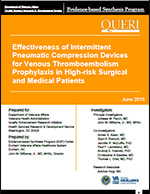
|
Principal Investigators:
Juliessa M. Pavon, MD;
John W. Williams, Jr., MD, MHSc Evidence-based Synthesis Program (ESP) Center Durham Veterans Affairs Healthcare System Durham, NC; Department of Veterans Affairs; June 2015 |
Download PDF: Complete Report, Abstract, Report, Appendices
This study was nominated by the Veterans Affairs (VA) National Surgery Office and Office of Nursing with the aim of evaluating IPCDs to inform best practice strategies, policy, and selection of devices for the VA Health System. The objective of this report is to evaluate the comparative effectiveness of IPCDs in post-operative surgical and high-risk medical patients of high interest to the Veterans Health Administration (VHA). There is a major gap in the existing literature on which specific populations will benefit from IPCD prophylaxis, and whether IPCDs vary importantly in VTE outcomes, adherence, and ease of use. This study addresses these gaps with a methodologically sophisticated systematic review.
Key Question 1: In hospitalized surgical patients at high risk for venous thromboembolism (VTE), what is the comparative effectiveness of VTE prophylaxis with intermittent pneumatic compression devices versus VTE prophylaxis with pharmacologic agents for VTE events, VTE-related mortality, and adverse events?
Key Question 2: In hospitalized medical patients at high risk for VTE, what is the comparative effectiveness of VTE prophylaxis with IPC devices versus VTE prophylaxis with pharmacological agents for VTE events, VTE-related mortality, and adverse events?
Key Question 3: In hospitalized surgical and medical patients at high risk for VTE, what is the comparative effectiveness of different IPC devices when compared to one another for preventing VTE events?
Key Question 4: When used for VTE prophylaxis, do different IPC devices differ in ease of use or adherence?
Effectiveness of Intermittent Pneumatic Compression Devices for Venous Thromboembolism Prophylaxis (Management eBrief)
Pavon J, Adam S, Razouki Z, McDuffie J, Lachiewicz P, Kosinski A, Beadles C, Ortel T et al. Effectiveness of Intermittent Pneumatic Compression Devices for Venous Thromboembolism Prophylaxis in High-Risk Surgical Patients: A Systematic Review. Journal of Arthroplasty. September 2015 (epublication ahead of print). (DOI: http://dx.doi.org/10.1016/j.arth.2015.09.043)